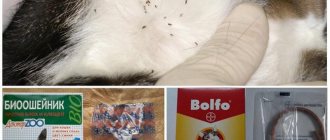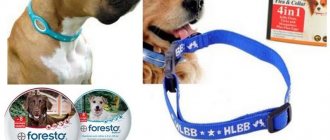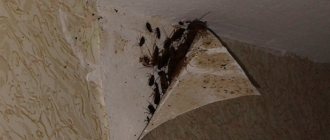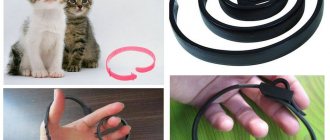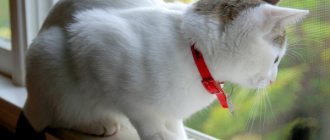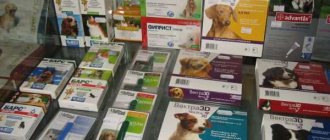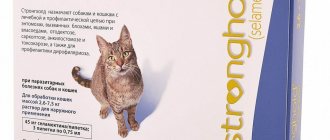How does a flea collar work?
To understand whether a flea collar helps cats and how this happens, it is enough to understand the mechanism of its action. There are two main options: repellent scented impregnation or radiation/ultrasound.
Does a domestic cat need a collar?
Even a pet sitting at home may need protection. When an anti-flea accessory is needed:
- fleas penetrate from the basement into the living space;
- the pet has contact with a walking animal, lives with it in the same territory;
- During the warm season, there is a surge in the number of fleas in the area or region.
If it’s cold winter outside and the cat is sitting at home, you can do without protection.
Mechanism and duration
The basic principle of operation of the accessory is simple: the repellent-insecticidal composition with which the material is treated repels or kills parasites. If a cat has a severe infection, then the healing process can be seen with the naked eye - the fleas begin an emergency “evacuation”. Only ultrasonic and radiating models differ in their principle of operation, but they are quite expensive, so they are in little demand. Ordinary products are harmless, the main thing is to comply with the conditions specified in the instructions for the product.
What substances are applied to the base of the accessory?
- Essential oils
(coniferous, citrus, mint, etc.). They play the role of repellents: they repel insects, are safe, but ineffective against parasites that have already settled in the fur.
- Imidacloprid
. A chemical that paralyzes fleas. Refers to modern pharmacological agents. Imidacloprid impregnation is effective for several months.
- Permethrin
. An effective insecticide, but its safety is questionable: the drug is quite poisonous, so if worn for a long time it can provoke functional disorders (liver disease, nervous system disorders).
- Sevin
. An effective insect repellent. Moderately toxic. It does not accumulate in wool and skin, but with prolonged use it can cause irritation or dermatitis.
- Propoxur
. Repellent and insecticidal agent. The effect of the main substance is visible within the first day. Moderately toxic, does not penetrate the blood, but spreads through the skin and fur.
- Metropen
. Gives 100% results, but is highly toxic. Veterinarians do not recommend it for weakened, lactating, pregnant cats, older animals, or kittens.
- Phenothrin
. Known both in veterinary and human pharmacology. Destroys adult parasites and their larvae.
- Fipronil
. Has a nerve-paralytic effect on insects. It is quite dangerous, as it can cause serious poisoning if it enters the body. It does not enter the blood through the skin and fur.
- Diazinon
. Repellent and insecticidal agent. Inhibits the nervous system of insects, paralyzing them. It spreads over the outer skin, but does not penetrate the bloodstream, often causing a bunch of allergic reactions.
- Tetrachlorvinphos
(TCVP). Harmless and hypoallergenic substance. Spreading over the outer integument of the animal, it does not penetrate the bloodstream.
It is important to use the anti-parasitic collar correctly. Even if this is not the first time you put it on an animal, read the instructions and follow all the requirements.
Does a flea collar help cats?
How a flea collar for cats works: it kills or paralyzes parasites, depending on the main working product. The active ingredients create a protective barrier on the animal's fur, preventing the infestation of fleas and ticks. How long the accessory will work depends on the type of impregnation, the activity of the cat (goes outside or not), and the degree of infection.
The level of efficiency also depends on the manufacturer, since not all companies carefully monitor compliance with the standards established in production. Conscientious companies use expensive imported materials, due to which the collar lasts up to six months and does not cause any side effects or complications.
We weigh the pros and cons
The popularity of anti-parasitic collars can easily be explained by their advantages. Anyone who has ever tried them on their pets will use them again. A short list of advantages:
- they are convenient and effective;
- have both a therapeutic and preventive effect;
- most models have a normal price, long shelf life;
- some accessories are suitable for treating pregnant, lactating, sick cats, as well as kittens;
- guarantee the cat's safety while walking.
With a quality product, the cat will be protected from parasite bites - and therefore from the diseases they carry.
Unfortunately, there are disadvantages that cannot be kept silent about:
- specific pungent aroma;
- risk of allergies, especially in sensitive pets;
- may cause hair loss on the neck;
- when wet, the product may lose its beneficial properties;
- ultrasonic models are very expensive;
- low-quality products cause cat poisoning.
The collar may cause individual intolerance. If your cat develops unpleasant symptoms, you should immediately remove the accessory and consult a veterinarian. The doctor will suggest an alternative method of protection against fleas.
Types of flea collars
There are four main types of anti-parasitic accessories. They are divided according to the principle of operation and the level of safety.
Biological
Made from rubber. Their main effect is protective; such models cannot cope with the destruction of existing fleas. Essential oils or natural poisons (usually from herbs) are used as impregnation for bio-collars. Such odors are harmless to cats, but perfectly repel ectoparasites. Bio-collars are not dangerous for the cat’s body and are environmentally friendly, although they can sometimes cause allergic reactions (itching, redness, dermatitis), this is due to individual intolerance. The shelf life of biomodels is approximately three months. Recommended for pregnant and lactating cats, as well as for kittens up to one year old.
Insecticidal
They are made from a rubber or polyvinyl chloride base and are impregnated with an antiparasitic composition. The advantages include their real effectiveness, and the disadvantages include the danger of toxic effects on the cat. Before use, it is recommended to stretch the device slightly to activate the active substance. Such products have a protective effect for several months.
Ultrasonic
The fabric base of the cat flea collar is supplemented with a mini-device that emits ultrasound, which is not perceptible to the human ear, but has a depressing effect on insects. It is completely harmless for pets. The mechanism is started by a battery, the performance of which determines the effectiveness of the accessory. Perhaps the only drawback of such devices is the significant price.
Radiating
The mechanism of action of the radiating collar is the propagation of electromagnetic waves, which have a destructive effect on ectoparasites. The advantages of this option include odorlessness and non-toxicity. However, they are not capable of adversely affecting eggs with larvae, and besides, the safety of electromagnetic radiation is a controversial issue.
Regardless of the model type, the listed accessories are suitable for representatives of all breeds: short-haired and long-haired.
Safety measures when disinfesting with aroma oils
Although essential oils are natural and do not contain foreign impurities or chemical compounds, certain safety precautions must be followed when working with them.
- It is not recommended to use if small children and pregnant women live in the apartment.
- read the instructions attached to the bottle. Use a small amount of oil, not in its pure form, especially for an aroma lamp, dilute it with water. Strong concentrations can cause nausea and headaches, and because... the oil does not evaporate for a long time, you will have to endure the irritating smell for several days;
- If you decide to buy oil for the first time, you do not need to immediately treat the entire room with it. No one has canceled individual intolerance to the drug, which can occur not only in humans in the form of allergic reactions, but also in pets;
Can there be side effects?
When using cat flea collars, be aware of possible side effects. Not all manufacturers use high-quality materials when making a product. When purchasing a flea collar for your cat, carefully read the instructions and make sure that the manufacturer has positive reviews. A low-quality product will do more harm than good. It is necessary to take into account that a flea and tick collar for cats, even from a trusted manufacturer, may have side effects. Among them the most common:
- skin irritation, allergies;
- hair loss;
- an unpleasant odor that causes severe discomfort to the animal.
During initial use, be sure to monitor possible changes in your pet’s behavior in order to help him in time - if necessary.
The cat was poisoned by a flea collar - what to do?
A negative reaction may not occur immediately, so do not let your guard down. What symptoms should you pay special attention to:
- lethargy, apathy;
- vomit;
- lack of appetite;
- constant itching on or near the neck;
- increased salivation.
If you notice at least one of the listed symptoms, remove the product and immediately contact your veterinarian. To avoid causing unnecessary stress to your pet, you can call a veterinarian to your home. While the doctor is visiting you, give the animal clean water to help the kidneys remove toxins from the body.
Cat itches from flea collar
If your cat keeps trying to scratch under the collar, there are two possible problems: allergies or simple chafing. In the second case, you can simply loosen the seal, and the itching will stop almost immediately. With allergies the situation is more complicated.
Allergy to flea collar
An allergic reaction can manifest itself as:
- itching;
- hair loss;
- redness of the neck, eyes, lacrimation;
- stuffy nose;
- red blisters on the skin with clear liquid.
Perhaps the animal is allergic to a component of the impregnation - try changing one model to another. If this doesn’t help, switch to sprays or ultrasonic collars.
Advantages and disadvantages
Benefits of using flea collars for cats:
- the most hygienic product;
- easy to use;
- efficiency is guaranteed;
- long-term protective effect;
- does not require large financial costs;
- chemicals do not settle on the skin;
- length adjustment.
Disadvantages of use:
- Some animals may have allergies;
- most products are not recommended for pregnant cats and young kittens (herbal or ultrasonic only);
- presence of an unpleasant odor;
- possible loss of hair on the neck;
In any case, you should not leave the animal without treatment. Even if the pet does not go outside and does not come into contact with stray animals, because the owner can bring the microscopic parasite to his home on his clothes.
Important! You should not buy too cheap fake analogues, which can be more harmful to the animal than parasitic creatures.
Attention! Insect parasites on wool are carriers of diseases dangerous to humans.
How to use the collar correctly
Even the best quality collar can be ineffective or harmful if used incorrectly. The surest way not to make a mistake is to read the instructions included with the product.
Precautions and contraindications
Like any medications, flea collars for cats have their own contraindications. Not all types are suitable for kittens, pregnant cats, sick and weakened animals. All restrictions are stated in the instructions.
For allergy sufferers, kittens and mother cats, special safe models are suitable: they will be recommended by a veterinarian or a seller at a veterinary pharmacy. Remember that babies under 2 months are vulnerable even to weak substances; for them, you need to choose a different method of getting rid of fleas.
Also, the animal should not wear the accessory all the time. The poisons it contains tend to accumulate in the animal’s body - this leads to diseases of the internal organs and disruption of the functioning of some body systems. To avoid this, take a break from wearing it every 3-4 months.
The health of your pet depends on compliance with basic requirements. Products from well-known manufacturers usually have detailed instructions on proper use and storage; these recommendations should not be neglected.
How to use the collar:
- After unpacking, the accessory is immediately put on the cat and precisely adjusted to size. It should be inaccessible for licking, but also not fit too tightly to the neck so as not to rub it.
- First, you need to put on the device for a short time and carefully monitor the cat’s condition to exclude allergic reactions.
- When an item is put away for storage, it should be packaged in a plastic bag or film.
- The expiration date is indicated in the instructions and varies from one month to six months.
The simultaneous use of several anti-parasitic agents, for example, a collar and shampoo/drops, is unacceptable. This can lead to acute intoxication. If the infestation is very serious, you can first use medicinal drugs, and after one or two weeks put on a collar.
Is a flea collar suitable for kittens?
Depending on the active substance used, the accessory may be contraindicated for kittens, since some poisons can be dangerous for a fragile organism. Collars for kittens have been developed especially for such cases. They have a smaller diameter and consist of safer components. But even before purchasing a specialized drug, carefully read the instructions at what age of the animal it can be used. Mostly biological varieties are suitable for kittens.
Can pregnant and lactating cats wear a collar?
This issue is very acute and should be approached with caution. Pregnant cats can be fitted with biological or ultrasonic collars, but it is best to consult a veterinarian before doing so. You shouldn't make a decision on your own.
It is recommended to avoid using flea collars for cats while nursing, as kittens may lick or bite the accessory during play. It is best to buy safe sprays or folk remedies (for example, put wormwood grass under the cat's bed).
When to put on and take off a collar
Do not remove the product from your pet until the expiration date, as this will provide better protection. In case of urgent need, the flea and tick cat collar can be removed and placed in a thick plastic bag - this way it will retain its properties longer.
It is better not to remove the product after walks, as there is a risk that some parasites may still remain on the animal’s body. If you are planning to give your pet a bath, you simply must remove all accessories before doing so.
Which flea collar for cats is better: review of manufacturers and prices
According to reviews from veterinarians and experienced breeders, the list of the most popular and in-demand brands includes the following.
Germany, Bolfo
. Inexpensive (450-500 rubles), but effective, suitable for representatives of all breeds. Available in several versions: weakly concentrated and highly concentrated impregnation. The duration of the effect is two to three months. Effective on all types of ectoparasites.
Holland, "Beaphar"
. Also inexpensive (300-400 rubles) and high-quality bio-collar. Essential oils are used as a repellent. It repels insects well, but does not affect existing fleas and larvae. It has a short shelf life (one to two months).
Russia, "Doctor Zoo"
. A reliable domestic manufacturer offers a very inexpensive option (50-70 rubles) with diazinon impregnation. The duration of its beneficial effect is several months. Low toxicity, hypoallergenic, comfortable to wear.
Russia, Bars
. A well-known brand offers a waterproof accessory with a fipronil medicinal composition. Price – 150-200 rubles. It is not inferior to more expensive imported analogues and perfectly repels all types of insects - from fleas to mosquitoes. Valid for no more than three months. Recommended for both adult cats and kittens.
USA, Hartz
. Not the cheapest (700-900 rubles), but a very high-quality option. Produces a destructive and repellent effect. It has a high level of hypoallergenicity. Not afraid of getting wet. Suitable for both adult cats and kittens.
Germany, RolfClub
. Ivermectin impregnation gives a lasting effect without a strong odor. It has a convenient clasp, a minimum number of contraindications and an affordable price - from 200 to 400 rubles.
Russia, “4 with a tail”
. Inexpensive domestic product within the cost of 100 rubles. It is impregnated exclusively with natural oils, so it is suitable for pregnant cats, kittens over 2 months old and adult animals.
The principle of action of essential oils against fleas
Aroma oil can be used not only as a means to add fragrance to a room, but also as an insecticide. Fleas, like all parasites, cannot tolerate strong odors. Essential oils for fleas in the apartment contain volatile substances that repel insects. They do not kill them, but only scare them away from the place where the oil was used.
What essential oils can repel fleas:
- sagebrush;
- eucalyptus;
- anise;
- peppermint and Japanese mint;
- thyme;
- lemongrass;
- pine;
- lavender;
- tea tree;
- Virginia cedar.
The listed flea aromatic oils will rid your premises of uninvited guests. But you need to be very careful when handling pet hair with them, because they can lick it off with their tongue, resulting in severe poisoning. It is better to use special shampoos for dogs and cats, collars for cats and dogs.
Drops that are applied to the animal’s withers have proven themselves to be excellent:
- Barrier;
- Dana Ultra Neo;
- Blokhnet;
- Inspector;
- Leopard;
- Celandine.
On a note!
Essential oil for fleas in cats causes disruption of the receptors responsible for the perception of odors, citrus fruits - lemon, orange and lemongrass - are especially unpleasant.
Lemon, orange and lemongrass

